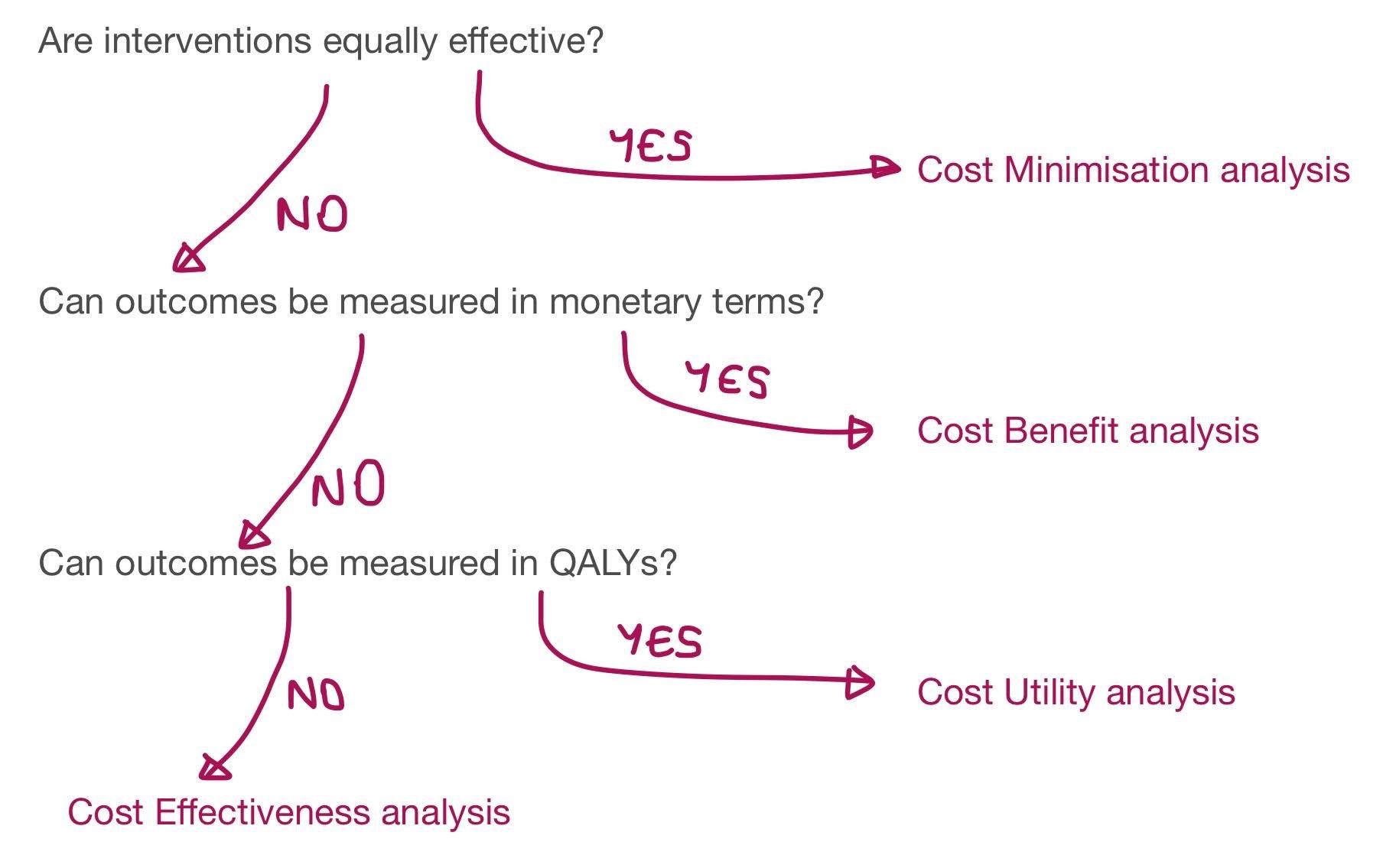Next Lesson - Evidence-Based Practice
Abstract
- Prioritisation in healthcare is inevitable due to demand outstripping supply. This is carried out by NICE in the UK, who use QALYs.
- Explicit reasoning is where all decisions are explained; implicit reasoning is where reasoning is not explained.
- There are four examples of cost benefit analysis, which are used in different situations.
Core
It is important to set priorities for allocation of healthcare resources because demand for healthcare outstrips supply and resources of healthcare. This raises difficult and complex ethical questions on who ‘deserves’ which resources.
In the UK NICE approves various treatments by using quality adjusted life years (QALYs):
1 year in perfect (100%) health = 1 QALY
10 years at 10% health = 1 QALY
Drugs are distributed in Britain by cost per QALY:
(Expected number of years the patient has left if they take the drug x cost per year) / QALYs gained = cost per QALY
NICE – National Institute for Health and Care Excellence
In the UK, NICE provides guidance on whether certain drugs should be funded on the NHS. This promotes equal access to these drugs across the country. However, its decisions can be controversial: if a potentially lifesaving drug is not funded by the NHS, it puts the responsibility on patients to fund it themselves if they wish to use it, and if a drug is approved by NICE, local NHS organisations must be able to provide it, meaning they may have to take budget away from other things to provide it.
NICE uses QALYs to justify its choices as a form of explicit reasoning.
NICE’s cost effectiveness threshold is currently about £20,000 to £30,000 per QALY. That means any treatments that are above £30,000 per QALY will not be approved by NICE as NHS funded treatment. This is of course not a concrete threshold and may be determined at times on a case by case basis
There are two main styles of reasoning when discussing resource allocation:
Explicit Reasoning – involves predetermined rules of entitlement and transparency.
- Advantages of explicit reasoning:
- Debatable and accountable, meaning decisions can easily be questioned.
- Evidence-based decisions are championed as those drawing up guidelines are held accountable.
- Disadvantages of explicit reasoning:
- Outcomes are assumed to be the same for all.
- Patients can feel distress if they are decided to be ‘undeserving’.
Implicit reasoning – involves making decisions without being clear about why those choices have been made.
- Advantages of implicit reasoning:
- Quicker because the decision makers don’t outspend time justifying their choices.
- Disadvantages of implicit reasoning:
- Can lead to inequality, favouritism, discrimination and abuse due to its closed nature.
- Can be based on ‘social deservingness’.
- Less accountable and egalitarian.
Key Terms for Health Economics
- Scarcity – resources are limited so prioritisation is inevitable.
- Technical Efficiency – the ability to get the most out of limited resources.
- Equity – the extent to which the distribution of resources is fair.
- Effectiveness – the ability of the intervention to produce the desired effect.
- Utility – the value that an individual places on their health state.
- Opportunity Cost – once money has been invested in a resource the opportunity cost is the ‘opportunity’ of investing in another resource which has been sacrificed. For example; you have enough money to buy either a chocolate bar or a biscuit. Purchasing the biscuit is done at the opportunity cost of the chocolate bar as now you have spent the money and can’t buy the chocolate bar thereby sacrificing it.
- Allocative Efficiency – distributing resources to meet as many needs as possible.
How to Compare Costs and Benefits
- Cost Minimisation Analysis – all outcomes are assumed to be equivalent and focus is only on the inputs (interventions to achieve the outcome of interest). The cheapest input is chosen. This model is unrealistic as it is rare for all outcomes to be equivalent.
- Cost Effectiveness Analysis – compares interventions which have a common outcome. Compared in terms of cost per unit outcome.
- Cost Benefit Analysis – All inputs and outputs are put in monetary terms and compared with inputs as ‘costs’ and outputs as benefits defined as ‘revenue’. This includes intangible benefits. The outcome with the best balance of cost vs benefit – in a sense ‘profit’ – is chosen (profit = revenue – costs). This method is limited by the difficulty of applying monetary values to intangible benefits.
- Cost Utility Analysis – Quality of health outcomes produced or foregone in QALYs. Cost per QALY.

Diagram - How to decide which type of analysis should be chosen in each situation
SimpleMed original by Maddie Swannack
Edited by: Dr. Ben Appleby
Reviewed by: Dr. Thomas Burnell
- 5141

